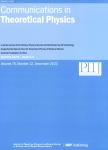Restoring cosmological concordance with axion-like early dark energy and dark matter characterized by a constant equation of state?
作者机构:School of Physics and Astronomy Sun Yat-sen University School of Physics Nankai University
出 版 物:《Communications in Theoretical Physics》 (理论物理)
年 卷 期:2024年第76卷第7期
页 面:76-84页
核心收录:
学科分类:07[理学] 070401[理学-天体物理] 0704[理学-天文学] 0702[理学-物理学]
基 金:supported by the National Key R&D Program of China (Grant No. 2020YFC2201600) the National Natural Science Foundation of China (NSFC) under Grant No. 12 073 088 the National SKA Program of China No. 2020SKA0110402
主 题:early dark energy Hubble tension noncold dark matter S8 tension
摘 要:The Hubble tension persists as a challenge in cosmology. Even early dark energy(EDE) models,initially considered the most promising for alleviating the Hubble tension, fall short of addressing the issue without exacerbating other tensions, such as the S8tension. Considering that a negative dark matter(DM) equation of state(EoS) parameter is conducive to reduce the value of the σ8parameter, we extend the axion-like EDE model in this paper by replacing the cold dark matter(CDM) with DM characterized by a constant EoS wdm(referred to as WDM hereafter).We then impose constraints on this axion-like EDE extension model, along with three other models: the axion-like EDE model, ΛWDM, and ΛCDM. These constraints are derived from a comprehensive analysis incorporating data from the Planck 2018 cosmic microwave background, baryon acoustic oscillations, and the Pantheon compilation, as well as a prior on H0(i.e. H0= 73.04 ± 1.04, based on the latest local measurement by Riess et al) and a Gaussianized prior on S8(i.e. S8= 0.766 ± 0.017, determined through the joint analysis of KID1000+BOSS+2dLenS). We find that although the new model maintains the ability to alleviate the Hubble tension to ~1.4σ, it still exacerbates the S8tension to a level similar to that of the axion-like EDE model.



